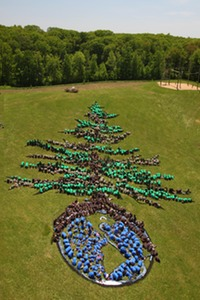Living Friendship Wampum
Michael White (2003) and David Denborough (2008) have introduced us to many examples of collective narrative documents. Denborough 2008, has described collective narrative documentation as involving the process of collaboration in constructing ways to archive and “…describe the skills and knowledges that people are engaging with to deal with hard times” (p 28). The documents take on many forms such as art, poems, written collections, lists, photos, etc. They serve as not only an archive of the communities collective wisdom and knowledge but also as a testament to shared hopes and preferences for the future.
Eastern White Pine Hugging The Earth- photo by: Daniel Dancer

In the Pen Pal Project we have had a lot of fun and excitement in co-creating collective documents. June 17th was the 2013 Pen Pal Gathering at Stoney Creek Battlefield House Museum and Park in Ontario Canada. This was the seventh such gathering of 1800 First Nations students and their neighbours since the side by side communities of Caledonia and Six Nations of the Grand River Territory came into conflict related to land rights dispute between the Crown represented by the Canadian Federal Government and the First Peoples. One of the very special activities over the years at these events has been to create a collective document as a means to archive the emerging story of relationship. I want to share a bit about this practice in this field note.
First lets explore the concept of ‘master narratives’ because narrative collective documents often stand in juxtaposition to master narratives. Lindemann Nelson (2001) exposes how master narratives are stories in cultures that “serve as summaries of socially shared understandings” (p. 6). As such, they “exercise a certain authority over our moral imaginations”, shaping worldviews of cultures, communities, and individuals. Master narratives ignore or underplay details promoting stock plots, archetypal themes, and recognizable character types (Lindemann Nelson, 2001). As such master narratives are influential, shaping meaning making and serving as justifications for actions. We very often see in the broadcast news master narratives of conflict, divide, and difference circulating related to many different circumstances. When left unexamined or without scrutiny those narratives can become all encompassing and difficult to dislodge. They can limit what becomes possible in complex situations and locate power with certain people leaving others to the side. Within a group or community context we can be active in eliciting the more subordinate stories or ‘stories in the making’ that when more richly drawn out may provide new proposals for action and/or collective re-definition. The development of narrative collective documents can serve as a means to have those stories come more visible.
Collective narrative documents while documenting shared hopes, preferences, and know-how also record a meaningful moment in time assisting the emerging story to endure and be shared widely. As such they often stand in juxtaposition to master narratives bringing their dominance into question and resisting assimilation into those narratives. As acts of 'cultural creativity' (Myerhoff, 2007) they are resonant with the cultures taking part often including meaningful cultural symbols, metaphors, and messages. They transcend time by evoking important images of the past, archiving the most present moment in recent history (the gathering) while simultaneously proposing what could be possible in the future. Finally these documents are circulated as a means to interest and captivate an audience who can share a re-presentation of what they have been shown (Myerhoff, 1986). That sharing brings greater meaning to the collective act, and increased visibility of a marginal voice.
Living Two Row Wampum Belt -photo by: Daniel Dancer
On this page you can share in three such collective documents (photos 2 and 3 by Daniel Dancer). The first (600 pen pals) is a representation of the Friendship Wampum Belt a treaty pledging friendship and everlasting peace between cultures. The second (1200 pen pals) is of an eastern white pine tree hugging the Earth. The eastern white pine, while being the official Ontario tree also represents the Tree of Peace. The third (1800 pen pals) document is a recreation of the Two Row Wampum Belt. These documents stand as invitations to consider ways of being with each other. They hearken back to the rich history of friendship that existed between the communities, and celebrate the rivers of connection. They honor treaties of the past and serve as expressions of a collective preference for friendship and peace.
What I will always remember about the events creating these documents are the smiling faces of the kids and their excitement trying to find themselves in these pictures afterwards. I believe they have a sense that they are part of something special.
In Curiosity,
Scot
References:
Denborough, D. (2008). Collective narrative practice: Responding to individuals, groups and communities who have experienced trauma. Adelaide, Australia: Dulwich Centre Publications.
Lindemann Nelson, H. (2001). Damaged identities, narrative repair. Cornell University Press, New York.
Myerhoff, B. (1986). Life not death in Venice: Its second life. In V. Turner & E. Bruner (Eds.) The anthropology of experience (pp. 261-286). Chicago: University of Illinois Press.
Myerhoff, B. (2007) in Kaminsky, M. & Weiss, M. (Eds.) Stories as Equipment for Living: Last talks and tales of Barbra Myerhoff. The University of Michigan Press, Ann Arbor, Michigan, USA
White, M. (2003) Narrative Practice and community assignments. International Journal of Narrative Therapy and Community Work, 2003 (2): 17-55.